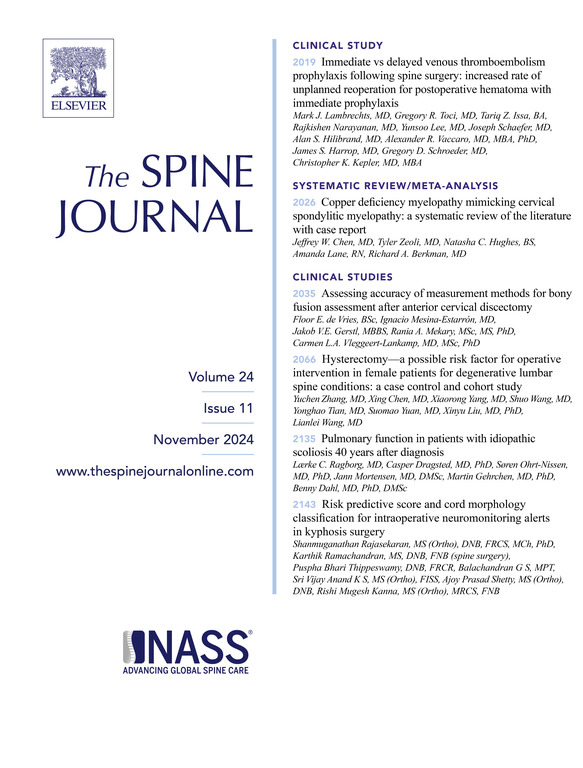万古霉素粉混合自体骨移植物和骨替代物可减少退行性疾病腰椎融合术中深部手术部位感染:一项前瞻性随机研究。
IF 4.7
1区 医学
Q1 CLINICAL NEUROLOGY
引用次数: 0
摘要
背景:腰椎内固定融合术后深部手术部位感染(DSSI)与相当高的发病率相关。术中应用万古霉素粉剂(VP)预防DSSI已被广泛应用;然而,VP与局部自体骨移植物(ABG)和骨替代物混合对DSSI预防和骨融合的影响尚不清楚。目的:探讨血凝素与ABG及骨替代物混合对DSSI及融合率的影响。研究设计/设置:在单一医疗中心进行的前瞻性随机病例对照研究。患者样本:从2017年10月至2023年5月招募了因腰椎退行性疾病接受减压和固定式融合手术的成年患者。患者被随机分为万古霉素组(n=357)和对照组(n=348)。万古霉素组2级和3级融合使用1 g抗生素粉(无1级融合),>3级融合使用2 g。指标:主要指标为指数术后90天内的DSSI。次要结局包括手术和万古霉素相关并发症、功能结局和骨融合。方法:所有患者术后1、2、3、6、12个月均行脊柱平片随访。DSSI的定义是基于疾病控制和预防中心对SSI的标准。采用Lenke标准评估后外侧融合,采用Brantigan-Steffee-Fraser (BSF)定义评估椎体间融合。在仰卧位动态屈伸侧位片上,固体融合被定义为融合节段的角度变化< 5°,Lenke分级为A级和B级或BSF-3定义。万古霉素组于术后第1天和第3天测定血清和引流管手术部位的抗生素浓度。采用Oswestry残疾指数(ODI)和视觉模拟量表(VAS)评估腿部疼痛的功能结局。结果:万古霉素组和对照组共纳入357例和348例患者。患者平均年龄67.7±11.0岁,女性占63.0%。万古霉素组无dssi,对照组5例(0比1.4%,p=0.029)。5例DSSI患者均合并糖尿病(100%)。万古霉素组糖尿病患者无发生DSSI (0/119 vs.对照组5/105,p=0.021)。术后血清万古霉素水平未检出,未见万古霉素相关并发症。术后第1天、第3天手术部位万古霉素平均浓度分别为524.5±209.9 μg/mL和217.4±97.2 μg/mL(在引流管中测量)。在最后的随访中,两组的功能结局和骨融合率相似。万古霉素组79.3%(257/324)和对照组73.5%(233/317)出现后外侧固性融合(Lenke A级或B级)(p=0.348)。根据BSF-3定义,万古霉素组99.4%(326/328)的笼子和对照组99.6%(258/259)的笼子出现了体间融合(p=1.000)。根据动态侧位片角度变化< 5°的标准,两组的固体融合率均为100%。结论:万古霉素与局部ABG和骨替代物混合可在手术部位维持较高的万古霉素水平,安全有效地预防腰椎退行性假体融合手术中的DSSI,且不影响骨融合,尤其是糖尿病患者。试验注册:ClinicalTrials.gov标识符:NCT03883022。本文章由计算机程序翻译,如有差异,请以英文原文为准。
Vancomycin powder mixed with autogenous bone graft and bone substitute may decrease the deep surgical site infections in elective lumbar instrumented fusion surgery for degenerative disorders: a prospective randomized study
Background Context
Deep surgical site infections (DSSI) following lumbar instrumented fusion surgery are associated with considerable morbidity. Intraoperative application of vancomycin powder (VP) has been widely used to prevent DSSI; however, the effects of VP mixed with local autogenous bone graft (ABG) and bone substitute on DSSI prevention and bone fusion remains unclear.
Purpose
To examine the effects of VP mixed with ABG and bone substitute on DSSI and fusion rate.
Study Design/Setting
A prospective randomized case-controlled study at a single medical center. (ClinicalTrials.gov Identifier: NCT03883022).
Patients’ Sample
Adult patients who underwent decompression along with instrumented fusion surgery for a degenerative lumbar condition were recruited from October 2017 to May 2023. Patients were randomly allocated to vancomycin (n=357) or control (without vancomycin) (n=348) groups. In the vancomycin group, 1 g of antibiotic powder was used for 2- and 3-level fusions (no 1 level fusions?) while 2 g was used for >3-level.
Outcomes Measures
The primary outcome was DSSI within 90 days after index surgery. Secondary outcomes included surgical and vancomycin-related complications, functional outcomes and bone fusion.
Methods
All patients were followed up with plain spine radiographs at 1, 2, 3, 6, and 12 months after surgery. The definition of DSSI was based on the Centers for Disease Control and Prevention criteria for SSI. Posterolateral fusion was assessed using the Lenke criteria and interbody fusion was assessed using the Brantigan-Steffee-Fraser (BSF) definition. Solid fusion was defined as an angular change of <5° of the fused segments in supine dynamic flexion and extension lateral radiographs, Lenke grade A and B or BSF-3 definition. Antibiotic concentrations in the vancomycin group were measured in the serum and at the surgical site in the drain on days 1 and 3 after the index surgery. Functional outcomes were evaluated by Oswestry Disability Index (ODI) and visual analog scale (VAS) for leg pain.
Results
In total, 357 and 348 patients were enrolled in the vancomycin and control groups, respectively. Mean patient age was 67.7±11.0 years and 63.0% were female. There were no DSSIs in the vancomycin group and five in the control group (0 vs 1.4%, p=.029). All five patients with DSSI had diabetes (100%). None of the patients with diabetes in the vancomycin group developed DSSI (0/119 vs 5/105 in control group, p=.021). Postoperative serum vancomycin levels were undetectable and no vancomycin-related complications were observed. The mean vancomycin concentrations at surgical site in the drain were 524.5±209.9 μg/mL and 217.4±97.2 μg/mL on postoperative days 1 and 3, respectively (measured in a drain?). At the final follow-up, functional outcomes and bone fusion rates were similar between the two groups. Solid posterolateral fusion (Lenke grade A or B) was observed in 79.3% (257/324) of the vancomycin group and 73.5% (233/317) of the control group (p=0.348). Interbody fusion, based on the BSF-3 definition, was observed in 99.4% (326/328) of cages in the vancomycin group and 99.6% (258/259) in the control group (p=1.000). Based on the criteria of angular change of < 5° on dynamic lateral radiographs, the solid fusion rate was 100% in both groups.
Conclusions
Vancomycin mixed with local ABG and bone substitute maintains high vancomycin level at surgical site and appears safe and effective for preventing DSSI in lumbar degenerative instrumented fusion surgery without affecting bony fusion, especially in diabetic patients.
Trial registration
ClinicalTrials.gov Identifier: NCT03883022.
求助全文
通过发布文献求助,成功后即可免费获取论文全文。
去求助
来源期刊

Spine Journal
医学-临床神经学
CiteScore
8.20
自引率
6.70%
发文量
680
审稿时长
13.1 weeks
期刊介绍:
The Spine Journal, the official journal of the North American Spine Society, is an international and multidisciplinary journal that publishes original, peer-reviewed articles on research and treatment related to the spine and spine care, including basic science and clinical investigations. It is a condition of publication that manuscripts submitted to The Spine Journal have not been published, and will not be simultaneously submitted or published elsewhere. The Spine Journal also publishes major reviews of specific topics by acknowledged authorities, technical notes, teaching editorials, and other special features, Letters to the Editor-in-Chief are encouraged.
 求助内容:
求助内容: 应助结果提醒方式:
应助结果提醒方式:


